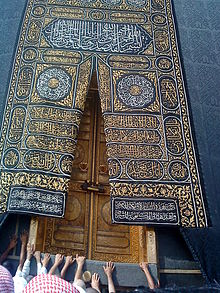Tawaf: Difference between revisions
Editor2020 (talk | contribs) |
Sam Sailor (talk | contribs) Filling in 1 references using Reflinks |
||
| Line 10: | Line 10: | ||
For men, it is recommended to make the first three circuits at a hurried pace, followed by four times, more closely, at a leisurely pace. |
For men, it is recommended to make the first three circuits at a hurried pace, followed by four times, more closely, at a leisurely pace. |
||
At the end of the circling, Muslims go to the [[ |
At the end of the circling, Muslims go to the [[Maqam Ibrahim|Station of Ibrahim]] to pray two ''nafl'' prayer [[rak'ah]]s, and then drink water from the sacred [[Well of Zamzam]], before proceeding to the next ritual of the Hajj, the [[S'ay]]. |
||
Muslims are generally advised to "make ṭawāf" at least twice – once as part of the Hajj, and again as their final activity before leaving Mecca.<ref name=AtoZ>{{Cite book| title=Hajj to Umrah: From A to Z | last = Mohamed | first= Mamdouh N. | year = 1996 | publisher=Mamdouh Mohamed | id= ISB 0-915957-54-x}}</ref> |
Muslims are generally advised to "make ṭawāf" at least twice – once as part of the Hajj, and again as their final activity before leaving Mecca.<ref name=AtoZ>{{Cite book| title=Hajj to Umrah: From A to Z | last = Mohamed | first= Mamdouh N. | year = 1996 | publisher=Mamdouh Mohamed | id= ISB 0-915957-54-x}}</ref> |
||
| Line 31: | Line 31: | ||
==Suggested significance== |
==Suggested significance== |
||
Attempts have been made to establish a connection between the act of ṭawāf and orbiting motions of heavenly bodies. It has been proposed, for example, that the act of ṭawāf closely resembles the shape of a galaxy when viewed from above (Muhammad Eusha, "Scientific Significance of Circling the Kaba", The Daily Sun, 11 February).<ref>http://www.daily-sun.com/?view=details&type=daily_sun_news&pub_no=125&cat_id=2&menu_id=37&news_type_id=1&index=3&archiev=yes&arch_date=11-02-2011</ref> But this view has not been verified by qualified [[ulama]]. |
Attempts have been made to establish a connection between the act of ṭawāf and orbiting motions of heavenly bodies. It has been proposed, for example, that the act of ṭawāf closely resembles the shape of a galaxy when viewed from above (Muhammad Eusha, "Scientific Significance of Circling the Kaba", The Daily Sun, 11 February).<ref>{{cite web|author=Hafez Ahmed @ http://www.daily-sun.com |url=http://www.daily-sun.com/?view=details&type=daily_sun_news&pub_no=125&cat_id=2&menu_id=37&news_type_id=1&index=3&archiev=yes&arch_date=11-02-2011 |title=Our Faith | The scientific significance of circling the Kaaba |publisher=daily sun |date=2011-02-11 |accessdate=2013-07-23}}</ref> But this view has not been verified by qualified [[ulama]]. |
||
==See also== |
==See also== |
||
Revision as of 10:49, 23 July 2013

Ṭawāf (طواف) is one of the Islamic rituals of pilgrimage. During the Hajj and Umrah, Muslims are to circumambulate the Kaaba (most sacred site in Islam) seven times, in a counterclockwise direction.[1] The circling is believed to demonstrate the unity of the believers in the worship of the One God, as they move in harmony together around the Kaaba, while supplicating to God.
Ritual details


The circle begins from the Black Stone (al-Ḥajar al-'Aswad) on the corner of the Kaaba. If possible, Muslims are to kiss or touch it, but this is often not possible because of the large crowds, so it is acceptable for them to simply point or hold up their hand to the Stone on each circuit. They are also to make the Takbir prayer (Allāhu Akbar) each time they approach.
For men, it is recommended to make the first three circuits at a hurried pace, followed by four times, more closely, at a leisurely pace.
At the end of the circling, Muslims go to the Station of Ibrahim to pray two nafl prayer rak'ahs, and then drink water from the sacred Well of Zamzam, before proceeding to the next ritual of the Hajj, the S'ay.
Muslims are generally advised to "make ṭawāf" at least twice – once as part of the Hajj, and again as their final activity before leaving Mecca.[2]
Types of Tawāf
There are several types of ṭawāf that can be performed:
- Ṭawāf an-Nisā' is a second ṭawāf performed during Umrah and sup. This type of ṭawāf is only recognised by Shia scholars.
- Ṭawāf al-Qudūm ("arrival ṭawāf") is performed by those not residing in Mecca once reaching the Holy City.
- Ṭawāf aṭ-Ṭaḥīyah is performed after entering the Masjid al-Haram at any other times and is mustahab.
- Ṭawāf al-cUmrah refers to the ṭawāf performed specifically for Umrah.
- Ṭawāf al-Wadāc ("farewell ṭawāf") is performed before leaving Mecca.
- Ṭawāf az-Zīyārah, Ṭawāf al-'Ifāḍah or Ṭawāf al-Ḥajj is performed after casting stones, sacrificing animals (hadi) shaving the hair.
Suggested significance
Attempts have been made to establish a connection between the act of ṭawāf and orbiting motions of heavenly bodies. It has been proposed, for example, that the act of ṭawāf closely resembles the shape of a galaxy when viewed from above (Muhammad Eusha, "Scientific Significance of Circling the Kaba", The Daily Sun, 11 February).[3] But this view has not been verified by qualified ulama.
See also
Notes
- ^ World Faiths, teach yourself - Islam by Ruqaiyyah Maqsood. ISBN 0-340-60901-X page 76
- ^ Mohamed, Mamdouh N. (1996). Hajj to Umrah: From A to Z. Mamdouh Mohamed. ISB 0-915957-54-x.
- ^ Hafez Ahmed @ http://www.daily-sun.com (2011-02-11). "Our Faith | The scientific significance of circling the Kaaba". daily sun. Retrieved 2013-07-23.
{{cite web}}: External link in|author=
References
- Shariati, Ali (2005). HAJJ: Reflection on Its Rituals. Islamic Publications International. ISBN 1-889999-38-5.
{{cite book}}: Cite has empty unknown parameter:|coauthors=(help) - Mohamed, Mamdouh N. (1996). Hajj to Umrah: From A to Z. Mamdouh Mohamed. ISB 0-915957-54-x.
- Hajj Leaflet
- The Hajj according to the Five Schools
- Hajj: The Pilgrimage
- [1]
- Denny, Frederick Mathewson (2010). An Introduction to Islam. Prentice Hall. ISB 0-13814477-X.
